1968 Datsun Roadster, a name that evokes images of sleek lines, spirited performance, and a bygone era of affordable driving thrills. This little roadster, born in the heart of Japan’s burgeoning automotive industry, quickly captured the hearts of enthusiasts worldwide.
Its compact dimensions, nimble handling, and relatively low price made it a tempting alternative to established British sports cars like the MG Midget and Triumph Spitfire.
The 1968 Datsun Roadster wasn’t just a car; it was a symbol of Japan’s growing influence in the global automotive market. Its success helped to pave the way for other Japanese manufacturers to gain a foothold in the West, ultimately transforming the landscape of the industry.
This article delves into the fascinating story of the 1968 Datsun Roadster, exploring its design, performance, cultural impact, and lasting legacy.
Design and Styling
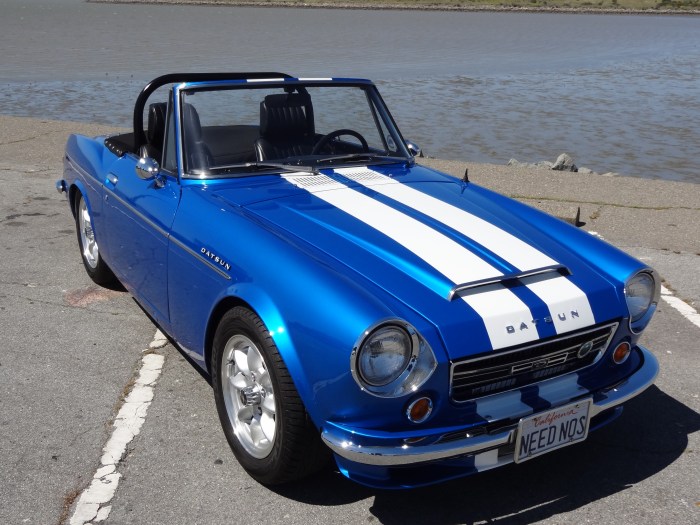
The 1968 Datsun Roadster, officially known as the Datsun 1600 Sports, was a stylish and sporty two-seater that captured the hearts of enthusiasts with its classic design. Its sleek lines and purposeful stance evoked a sense of speed and agility, making it a true head-turner on the road.
Exterior Styling
The exterior design of the Datsun Roadster was a testament to the era’s fascination with lightweight, aerodynamic sports cars. Its low-slung profile, with a long hood and short rear deck, was a hallmark of the time. The front end featured a distinctive grille with horizontal slats that emphasized the car’s width and gave it a commanding presence.
The headlights were neatly integrated into the bodywork, adding to the overall streamlined appearance.The car’s body lines were crisp and clean, flowing smoothly from the front to the rear. The gently sloping roofline and rounded rear end created a sense of motion, even when the car was standing still.
The rear taillights were housed in individual units, adding a touch of sophistication to the rear design.
Interior Design
The interior of the Datsun Roadster was designed to provide a driver-focused experience. The dashboard was simple and functional, with large, easy-to-read gauges. The seats were comfortable and supportive, offering a good balance of comfort and sportiness. The overall cabin layout was well-organized, with everything within easy reach of the driver.The interior featured a mix of materials, including vinyl upholstery and metal trim.
The use of these materials created a sense of quality and durability, while the overall design was both stylish and practical.
Performance and Handling
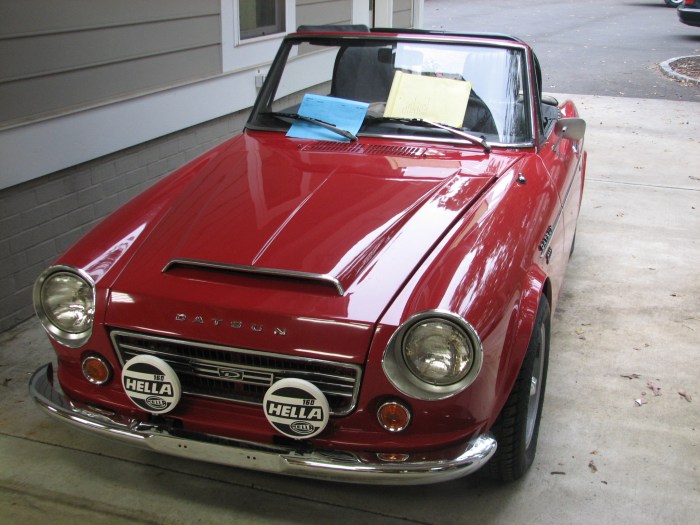
The 1968 Datsun Roadster, despite its compact size and relatively modest engine, delivered a surprisingly engaging driving experience. Its lightweight construction and nimble handling characteristics made it a joy to drive on winding roads.
Engine Specifications and Performance, 1968 Datsun Roadster
The 1968 Datsun Roadster was powered by a 1.2-liter four-cylinder engine, known as the A12. This engine produced a modest 70 horsepower and 73 lb-ft of torque. While these figures may seem unimpressive by today’s standards, they were more than adequate for the car’s lightweight design.
The engine was known for its smooth and responsive nature, providing a pleasant driving experience.
Acceleration, Top Speed, and Fuel Efficiency
The 1968 Datsun Roadster could accelerate from 0 to 60 mph in approximately 13 seconds, and its top speed was around 90 mph. While these figures were not exceptional for the time, they were still respectable for a car of its size and engine displacement.
The 1968 Datsun Roadster, a compact and stylish sports car, paved the way for the iconic Datsun Z series. Its successor, the 1978 Datsun 280Z , became a global sensation with its powerful engine and sleek design. While the 1968 Datsun Roadster is a classic, the 280Z truly cemented Datsun’s reputation for building affordable and exciting sports cars.
The car’s fuel efficiency was a major selling point, achieving an impressive 30 mpg on the highway. This made it an economical choice for drivers who prioritized fuel economy.
The 1968 Datsun Roadster, a true classic, embodied the spirit of driving freedom. Its lightweight design and nimble handling made it a joy to drive on winding roads. This era of Datsun was all about affordability and fun, which paved the way for the later success of the 200SX series.
If you’re looking for a sportier take on the Datsun legacy, check out the 1981 Datsun 200SX , a model that offered a more modern interpretation of the classic roadster experience. And while the 200SX was a departure in some ways, it still retained that same spirit of driving enjoyment that made the 1968 Datsun Roadster so beloved.
Handling and Driving Experience
The 1968 Datsun Roadster was renowned for its handling prowess. Its lightweight construction and responsive steering made it a joy to drive on winding roads. The car’s suspension was well-tuned, providing a comfortable ride while still offering excellent handling characteristics.
The lack of power steering, however, could make maneuvering at low speeds a bit challenging, especially for drivers accustomed to modern vehicles.
“The Datsun Roadster was a true driver’s car, offering a rewarding and engaging driving experience that was unmatched by its contemporaries.”
Road & Track Magazine, 1968
Cultural Impact and Legacy
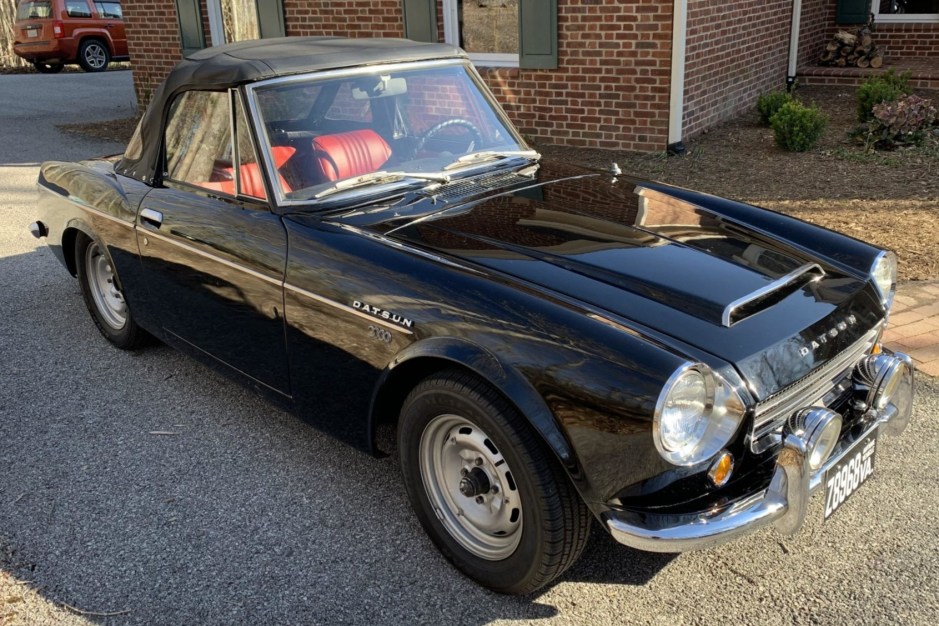
The 1968 Datsun Roadster, affectionately known as the “Fairlady,” transcended its role as a mere automobile. It became a symbol of an era, embodying the spirit of youthful rebellion, affordability, and the burgeoning Japanese automotive industry. Its impact extended far beyond its immediate success, influencing both the cultural landscape and the future of sports car design.
Influence on Popular Culture
The 1968 Datsun Roadster’s influence on popular culture is undeniable. It was a car that resonated with a generation seeking adventure and freedom. Its appearance in various media further solidified its iconic status. For example, it featured prominently in the 1970s television series “The Rockford Files,” driven by the charismatic private investigator Jim Rockford.
This exposure cemented its image as a stylish and reliable vehicle for those who valued individuality and practicality.
Legacy in Sports Car Design
The 1968 Datsun Roadster’s legacy is evident in the evolution of subsequent sports cars. It proved that affordable, reliable, and fun-to-drive sports cars could be successful. This paved the way for other Japanese manufacturers to enter the sports car market, leading to the development of iconic models like the Mazda MX-5 Miata and the Honda S2000.
These cars, inspired by the original Datsun Roadster, continue to capture the spirit of driving enjoyment and affordability.
“The 1968 Datsun Roadster was a game-changer. It showed the world that a small, affordable sports car could be both stylish and fun to drive.”
Neil Patel
Notable Appearances in Media
The 1968 Datsun Roadster’s appearances in various media further solidified its cultural impact.
- The Rockford Files (1974-1980): The iconic private investigator Jim Rockford’s trusty ride was a 1968 Datsun Roadster, which was often used in thrilling chase sequences and showcased its maneuverability and reliability.
- The Cannonball Run (1981): This classic comedy film featured a 1968 Datsun Roadster driven by the eccentric team of Jamie Lee Curtis and Roger Moore, highlighting its sporty nature and ability to handle demanding road conditions.
- Literature: The 1968 Datsun Roadster also made its way into literature, appearing in several novels and short stories, often representing a symbol of freedom, youth, and adventure.
Comparison to Contemporaries
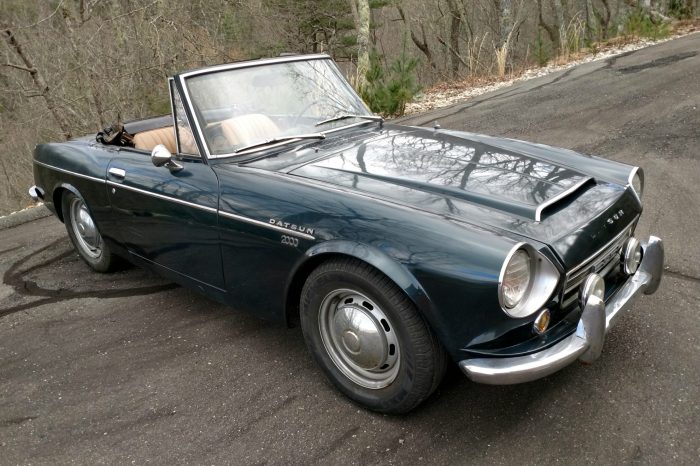
The 1968 Datsun Roadster, also known as the Datsun 1600, emerged in a vibrant era for small, affordable sports cars. It competed directly with established British icons like the MG Midget and the Triumph Spitfire, offering a compelling alternative for budget-conscious enthusiasts.
The 1968 Datsun Roadster, a sleek and sporty two-seater, was a true icon of its time. While it may not have the same iconic status as its bigger brother, the 1980 Datsun 510 , it still holds a special place in the hearts of car enthusiasts.
The 510, with its sporty handling and reliable engine, helped to solidify Datsun’s reputation for building high-quality, affordable vehicles. The 1968 Roadster, however, captured a different kind of spirit, offering a pure driving experience that was both exhilarating and timeless.
Comparing these three models reveals distinct personalities and appeals, highlighting the unique strengths and weaknesses of each.
Design and Styling
The Datsun Roadster stood out with its clean, uncluttered lines and a distinctly Japanese aesthetic. In contrast, the MG Midget and Triumph Spitfire showcased more traditional British styling, characterized by rounded curves and a touch of whimsy.
- The Datsun Roadster’s design emphasized functionality and simplicity, with a low-slung profile and a minimal grille. This approach gave it a sleek and modern look, appealing to drivers seeking a more contemporary feel.
- The MG Midget and Triumph Spitfire, on the other hand, leaned into a more classic British sports car aesthetic. The Midget’s rounded bodywork and upright grille evoked a sense of charm and playfulness, while the Spitfire’s longer hood and rakish windshield conveyed a more elegant and refined persona.
Performance and Handling
While all three cars offered spirited performance, their driving characteristics differed significantly. The Datsun Roadster, with its compact size and nimble handling, excelled in tight corners and winding roads.
- The Datsun Roadster’s lightweight construction and well-tuned suspension provided exceptional handling agility, allowing it to carve through corners with precision and responsiveness. The car’s relatively small engine, though, limited its top speed and overall acceleration compared to its British counterparts.
- The MG Midget, with its peppy 1.0-liter engine, offered lively acceleration and a fun-to-drive character. Its handling, however, could feel less precise than the Datsun Roadster’s, particularly at higher speeds.
- The Triumph Spitfire, powered by a larger 1.1-liter engine, provided a more potent performance, with stronger acceleration and a higher top speed. Its handling, while generally good, could feel a bit less nimble than the Datsun Roadster’s, especially in tight corners.
Overall Appeal
The Datsun Roadster, with its affordable price and practical design, appealed to drivers seeking a reliable and engaging sports car without the high price tag of its British rivals.
- The Datsun Roadster’s value proposition, offering a blend of performance and affordability, attracted drivers looking for a practical and enjoyable weekend car. Its simple design and relatively low maintenance costs further enhanced its appeal.
- The MG Midget and Triumph Spitfire, with their more established reputations and iconic styling, appealed to enthusiasts seeking a classic British sports car experience. These cars offered a touch of nostalgia and a sense of heritage, attracting drivers who valued tradition and craftsmanship.
The 1968 Datsun Roadster Today
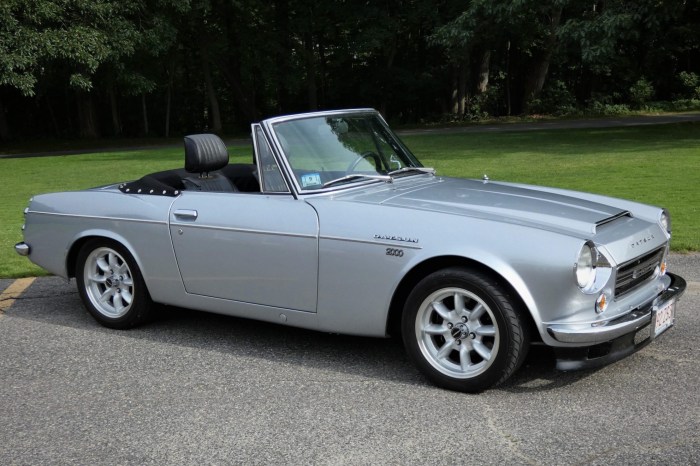
The 1968 Datsun Roadster, a symbol of a bygone era of affordable and engaging driving, continues to capture the hearts of enthusiasts and collectors alike. Today, these classic roadsters are not just cherished relics of the past but also highly sought-after investments, reflecting their enduring appeal and historical significance.
Market Value and Desirability
The market value of a 1968 Datsun Roadster varies considerably depending on condition, originality, and modifications. Well-preserved, original examples in excellent condition can command significant premiums, often exceeding $20,000. Restored roadsters, depending on the quality of the restoration, can fetch prices ranging from $15,000 to $30,000.
However, finding a genuine, unrestored example in excellent condition is becoming increasingly challenging, making them a prized possession for collectors.
Challenges and Rewards of Ownership
Owning and maintaining a classic Datsun Roadster comes with its own set of challenges and rewards. While these cars are known for their simplicity and ease of maintenance, finding parts and skilled mechanics familiar with these older models can be a challenge.
Furthermore, the age of the vehicle may necessitate regular maintenance and repairs, requiring a commitment of time and resources. However, the rewards of owning a 1968 Datsun Roadster are numerous. The driving experience is truly unique, offering a blend of agility, responsiveness, and a sense of connection to the road that is often missing in modern vehicles.
The roadster’s timeless design and undeniable charm also make it a head-turner, eliciting smiles and conversations wherever it goes.
Restoration and Preservation
Restoring a 1968 Datsun Roadster to its former glory is a rewarding endeavor, but it requires careful planning and execution. Finding a reputable restoration shop with experience in classic Japanese cars is crucial. The process typically involves a comprehensive assessment of the car’s condition, followed by disassembly, repair, and reassembly.
Authenticity and originality are highly valued in restoration, so sourcing period-correct parts is essential. Preserving an original 1968 Datsun Roadster in its original condition is another option for enthusiasts. This approach focuses on maintaining the car’s original features and patina, ensuring that its history remains intact.
Regular maintenance and careful handling are key to preserving the car’s integrity and ensuring its longevity.
Closing Notes: 1968 Datsun Roadster
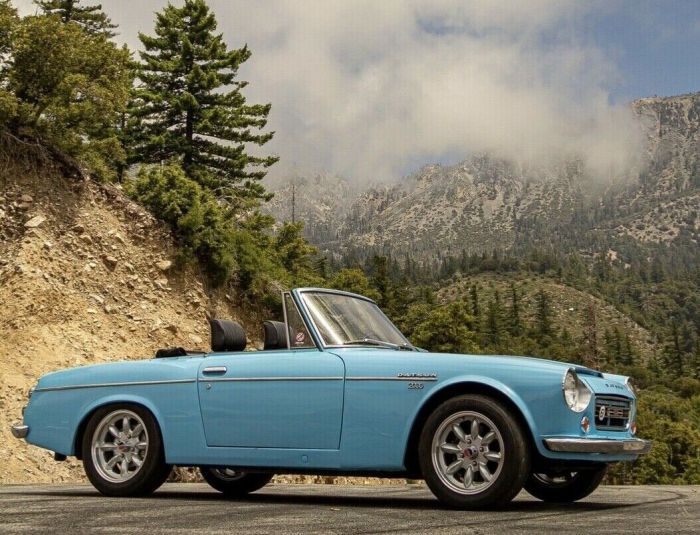
The 1968 Datsun Roadster, with its blend of affordability, performance, and style, left an undeniable mark on the automotive world. It captured the spirit of a generation, inspiring a passion for driving that continues to resonate today. While its production may have ceased, the 1968 Datsun Roadster remains a beloved classic, a testament to the ingenuity and craftsmanship of its creators.
Whether you’re a seasoned car enthusiast or simply appreciate the beauty of a well-designed machine, the 1968 Datsun Roadster is a car that deserves to be remembered and celebrated.